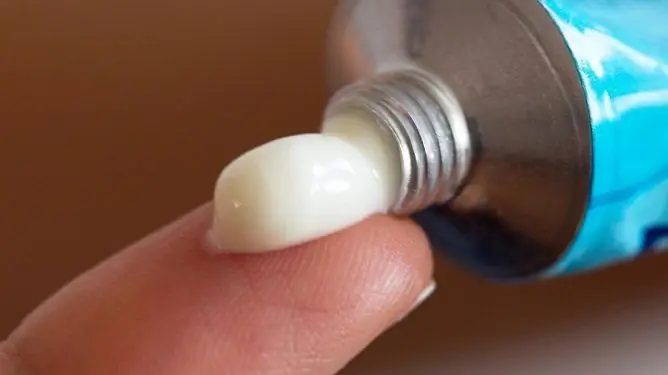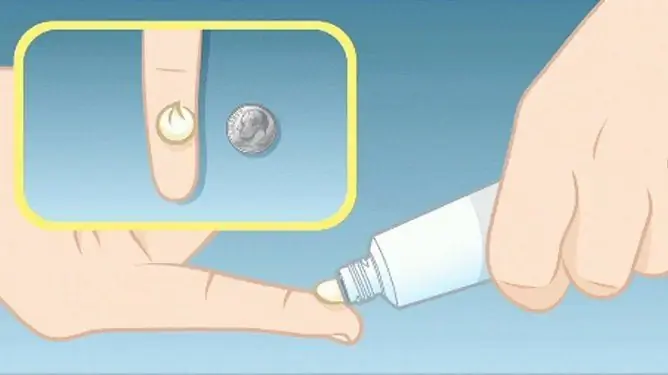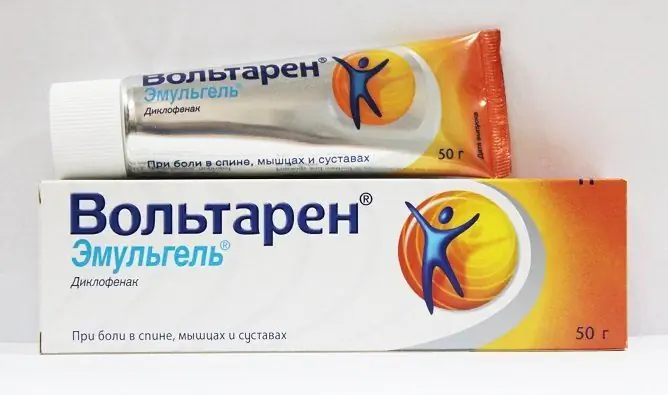- Author Rachel Wainwright [email protected].
- Public 2023-12-15 07:39.
- Last modified 2025-11-02 20:14.
Alpizarin
Alpizarin: instructions for use and reviews
- 1. Release form and composition
- 2. Pharmacological properties
- 3. Indications for use
- 4. Contraindications
- 5. Method of application and dosage
- 6. Side effects
- 7. Overdose
- 8. Special instructions
- 9. Drug interactions
- 10. Analogs
- 11. Terms and conditions of storage
- 12. Terms of dispensing from pharmacies
- 13. Reviews
- 14. Price in pharmacies
Latin name: Alpisarin
ATX code: J05AX
Active ingredient: tetrahydroxyglucopyranosilxanten (tetrahydroxyglucopyranosilxanten)
Manufacturer: CJSC "Pharmcenter VILAR", Russia
Description and photo update: 2019-13-08
Prices in pharmacies: from 69 rubles.
Buy

Alpizarin is an antiviral drug.
Release form and composition
Alpizarin is released in the form:
- Light yellow homogeneous ointment for external use containing 2 or 5 g of active ingredient and an auxiliary component - medical petroleum jelly per 100 g of ointment. In aluminum tubes or cans of 10 g and 20 g;
- Tablets containing 100 mg of active ingredient and auxiliary components - milk sugar, potato starch, calcium stearate. 10-30 pieces per pack.
The active ingredient of Alpizarin - tetrahydroxyglucopyranosylxanthene, isolated from mango leaves, has a bacteriostatic, antibacterial, antiviral and immunostimulating effect.
Pharmacological properties
Pharmacodynamics
Alpizarin is made from the mangiferin contained in the leaves of the Indian mango - Mangifera indica L., belonging to the sumac family Anacardiaceae. It is characterized by antiviral activity against viruses such as cytomegalovirus, Herpes zoster, Herpes simplex types 1 and 2, Varicella zoster.
In vitro experiments proved that tetrahydroxyglucopyranosylxanthene exhibits inhibitory properties against the human immunodeficiency virus. The drug inhibits the reproduction of the virus, especially at an early stage, without affecting the activity of viral neuraminidase.
Alpizarin exhibits immunostimulating properties with respect to humoral and cellular immunity, and is also able to activate the synthesis of interferon gamma in blood cells.
Alpizarin inhibits the reproduction of pathogenic protozoa (Trichomonas vaginalis, Entamoeba histolytica), gram-positive (Mycobacterium tuberculosis, Staphylococcus aureus) and gram-negative (Escherichia coli) microorganisms and fungi (Microsporum canis). The mechanism of action of the drug is the ability to inhibit the activity of bacterial nuclease. Alpizarin is characterized by a moderate anti-inflammatory effect.
Pharmacokinetics
When taken orally, tetrahydroxyglucopyranosylxanthene is rapidly absorbed from the gastrointestinal tract. In blood plasma, it is found unchanged for 0.5-5 hours after ingestion. The maximum concentration of the substance, which is 4.5 μg / ml, is recorded 1 hour after the use of Alpizarin. The degree of binding of tetrahydroxyglucopyranosylxanthene with blood proteins is quite significant and amounts to 70-90%.
The active component of the drug is excreted mainly by the extrarenal route. The excretion of tetrahydroxyglucopyranosylxanthene unchanged in the urine does not exceed 0.1% in 24 hours.
Indications for use
The antiviral activity of Alpizarin is manifested against the viruses of chickenpox, herpes zoster, herpes simplex and cytomegalovirus. The drug also has a mild bacteriostatic effect against some gram-positive and gram-negative bacteria, mycobacterium tuberculosis and parasitic protozoa. The drug does not possess allergenic and local irritating properties.
The use of Alpizarin is most effective in the early stages of the disease.
According to the instructions, Alpizarin is used in adults and children in the treatment of:
- Viral diseases of the oral mucosa (aphthous stomatitis);
- Recurrent and acute infections caused by the herpes simplex virus of various localization, including genital herpes (as part of combination therapy);
- Shingles;
- Cytomegalovirus infection;
- Kaposi's herpetiform eczema;
- Chickenpox.
Contraindications
According to the instructions, Alpizarin is contraindicated in case of hypersensitivity to the components of the ointment or tablets.
Pregnancy is also a contraindication to the use of any dosage form of the drug; during lactation, Alpizarin is allowed to be used strictly according to indications.
In pediatrics, the use of:
- Ointments - from 1 year;
- Tablets - from 3 years old.
Instructions for the use of Alpizarin: method and dosage
The best therapeutic effect is achieved when Alpizarin is prescribed at the onset of the disease or at the first signs of relapse. The tablets can be taken with or without food:
- Adults and children over 12 years old - up to 2 tablets 3-4 times a day;
- Children 6-12 years old - up to 3 times a day, 1 tablet;
- Children 1-6 years old - 2-3 times a day, 1 / 2-1 tablet.
The maximum daily dosage of Alpizarin is:
- For children 3-12 years old - 3 tablets;
- For adults and children over 12 years old - 8 tablets.
The duration of treatment is determined by the disease:
- Kaposi's herpetiform eczema and cytomegalovirus infection - 7-21 days (as part of complex therapy);
- Aphthous stomatitis - 5-15 days;
- Diseases caused by Herpes zoster (shingles) and Varicella zoster (chickenpox) - 5-21 days.
For the prevention of recurrence of herpesvirus infections after completion of treatment, Alpizarin is taken for another 10-14 days. In case of relapses, repeated courses of treatment are carried out.
Alpizarin ointment is applied every 4-6 hours. The duration of therapy is determined by the disease.
Side effects
When using Alpizarin, allergic reactions may occur.
Overdose
To date, no cases of Alpizarin overdose have been registered. The likelihood of significant side effects when taking the drug in high doses is extremely low.
special instructions
In the event of herpetic eruptions, as well as against the background of lymphadenopathy, fever and other general phenomena, it is possible to use the ointment simultaneously with the tablets.
Influence on the ability to drive vehicles and complex mechanisms
Alpizarin does not significantly affect the ability to drive vehicles or perform potentially hazardous types of work that require increased concentration and quick psychomotor reactions (for example, working with moving mechanisms).
Drug interactions
There is no information on the interaction of tetrahydroxyglucopyranosylxanthene with other drugs.
Analogs
According to the mechanism of action, the analogues of Alpizarin are: Allokin-alpha, Isoprinosin, Amizon, Ingavirin, Amiksin, Groprinosin, Arbidol, Viracept, Armenicum, Hyporamine, Ferrovir, Proteflazid, Panavir, Oxolin, Kagocelferon, Tselviaxentrumax, Tselvirin, Yodantipirin, Lirasept, Isentress, Tiloron, Fuzeon.
Terms and conditions of storage
Store in a dark place, out of reach of children, at a temperature not exceeding 25 ° C.
The shelf life, regardless of the dosage form, is 5 years.
Terms of dispensing from pharmacies
Dispensed by prescription.
Reviews about Alpizarin
Most patients who underwent a course of drug therapy leave positive reviews about Alpizarin. It is considered especially effective in the treatment of herpes, including genital. Usually Alpizarin is used as one of the elements of combination therapy.
The price of Alpizarin in pharmacies
The approximate price for Alpizarin in the form of tablets is 186-210 rubles (the package includes 20 pcs.). Alpizarin ointment 2% can be bought for 78-116 rubles, and 5% ointment for 96-130 rubles (the tube contains 10 g).
Alpizarin: prices in online pharmacies
|
Drug name Price Pharmacy |
|
Alpizarin 2% ointment for local and external use 10 g 1 pc. RUB 69 Buy |
|
Alpizarin 5% ointment for local and external use 10 g 1 pc. RUB 85 Buy |
|
Alpizarin 100 mg tablets 20 pcs. RUB 165 Buy |
|
Alpizarin tablets 100mg 20 pcs. 193 r Buy |

Anna Kozlova Medical journalist About the author
Education: Rostov State Medical University, specialty "General Medicine".
Information about the drug is generalized, provided for informational purposes only and does not replace the official instructions. Self-medication is hazardous to health!






